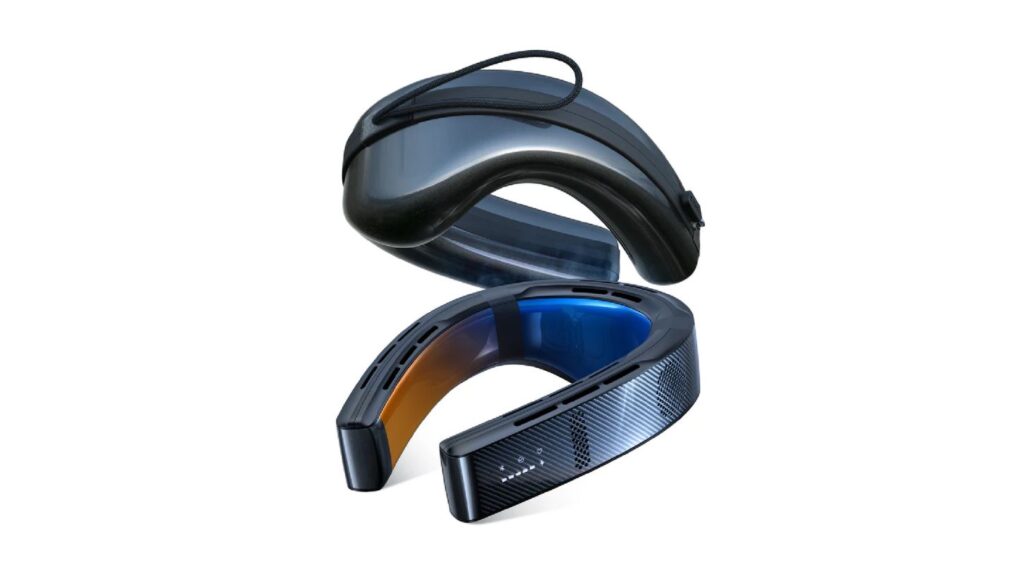As temperatures rise and the sun beats down, the quest for comfort becomes paramount.
The importance of staying cool cannot be overstated, especially during sweltering summer months. In this battle against the heat, two contenders stand out: neck cooling fans and traditional cooling methods.
Let’s delve into these contenders and explore their features to determine which one emerges victorious in providing ultimate comfort during scorching days.
Neck Cooling Fans
These innovative devices harness the power of airflow to deliver a refreshing and revitalizing cooling effect.
By circulating air around the neck area, they create a localized breeze that effectively lowers body temperature.
The design and wearability of neck air conditioner play a crucial role in their effectiveness.
Typically, these devices are ergonomically crafted to fit comfortably around the neck, ensuring maximum contact with the skin for optimal cooling.
The lightweight and unobtrusive nature of these fans allows for unhindered movement, making them suitable for various activities and environments.
Benefits of Neck Cooling Fans
The primary advantage of neck cooling fans lies in their portability and convenience.
Unlike traditional cooling methods that may require stationary positioning, these fans can be worn on the go, providing continuous relief during outdoor excursions or while engaging in physical activities.
Moreover, neck cooling fans boast impressive energy efficiency and eco-friendliness. With rechargeable battery options and low power consumption, they offer a sustainable alternative to traditional cooling appliances.
This not only reduces electricity usage but also aligns with environmentally conscious practices, contributing to a greener lifestyle.
ALSO READ: TESSAN Launches Award-Winning Level 2 EV Charger, Setting New Standards in Electric Vehicle Charging
Traditional Cooling Methods
When it comes to combating the heat, traditional cooling methods have long been relied upon for their ability to provide relief in various settings.
Fans and air conditioners are stalwart fixtures in homes and offices, offering widespread cooling through the circulation of air. These appliances work by moving air around a space, dissipating heat and creating a more comfortable environment.
In addition to mechanical cooling devices, ice packs and cooling towels have been go-to choices for individuals seeking quick relief from high temperatures.
Ice packs are designed to absorb and disperse heat when placed on the body, while cooling towels utilize evaporative technology to create a refreshing sensation on the skin.
Why Traditional Methods Fall Short
Lack of Portability
One significant limitation of traditional cooling methods is their lack of portability. Fans and air conditioners are fixed in place, restricting their use to specific locations within a home or building.
This immobility can be particularly challenging during outdoor activities or when moving between different areas, as the cooling effect is confined to a single space.
Similarly, ice packs and cooling towels, while portable to some extent, require access to frozen or cold sources for continued use.
This dependency on refrigeration limits their practicality in situations where such resources may not be readily available.
Higher Energy Consumption
Another drawback of traditional methods lies in their higher energy consumption compared to modern alternatives.
Fans and air conditioners rely on electricity to power their operation, contributing to increased utility costs and environmental impact.
The continuous running of these appliances can lead to substantial energy usage, especially in larger spaces or during extended periods of hot weather.
Similarly, the production and maintenance of ice packs also contribute indirectly to energy consumption through refrigeration processes.
The need for consistent freezing or chilling results in ongoing energy expenditure that contrasts with more sustainable approaches offered by innovative cooling solutions.
In light of these limitations associated with traditional cooling methods, it becomes evident that advancements in personal cooling technology present compelling alternatives that address these shortcomings effectively.
Neck Cooling Fans vs. Traditional Methods: Comparative Analysis
Immediate vs. Gradual Cooling
When comparing the effectiveness of neck cooling fans and traditional methods, one crucial aspect to consider is the speed of cooling they offer.
Neck cooling fans provide immediate relief by generating a continuous flow of air around the neck area, rapidly lowering body temperature.
This instant cooling effect is especially beneficial during hot weather or physical exertion when quick relief is essential for comfort and well-being.
On the other hand, traditional methods such as fans, air conditioners, ice packs, and cooling towels typically offer a more gradual cooling process.
While they can create a cooler environment over time, they may not provide the immediate personal relief that neck cooling fans deliver.
Targeted Cooling Areas
Another significant advantage of neck cooling fans lies in their ability to target specific areas for cooling.
By directing airflow to the neck and upper chest region, these fans focus on areas where body heat tends to accumulate, effectively reducing discomfort and promoting a sense of overall coolness.
In contrast, traditional methods disperse cool air or cold sensations more broadly across a space or surface.
While this can create a generally comfortable atmosphere, it may not address localized heat buildup as effectively as the targeted approach offered by neck cooling fans.
Ease of Use in Various Settings
Neck cooling fans excel in versatility and ease of use across diverse settings. Whether indoors or outdoors, at work or during leisure activities, these portable devices seamlessly integrate into various lifestyles without imposing restrictions on movement or daily routines.
Their hands-free design allows individuals to stay cool while remaining active and engaged in different environments.
In contrast, traditional methods such as stationary fans and air conditioners are limited by their fixed positioning within indoor spaces.
While effective within their designated areas, they do not offer the same level of adaptability for individuals who require mobility while staying cool.
Additionally, ice packs and cooling towels necessitate access to frozen sources or water for activation, which may not always be feasible in certain settings or circumstances.
The reliance on external resources limits their usability compared to the self-contained nature of neck cooling fans.
Maintenance and Care
Maintenance requirements also factor into the comparison between neck cooling fans and traditional methods.
The streamlined design of neck cooling fans, coupled with their rechargeable battery options and durable construction, minimizes maintenance needs.
Regular charging ensures continuous functionality without the need for frequent part replacements or extensive upkeep.
In contrast, traditional methods such as air conditioners may require periodic filter changes, system inspections, and professional servicing to maintain optimal performance.
Similarly, ice packs need regular freezing cycles to remain effective while also posing potential challenges related to leakage or wear over time.
ALSO READ: Wanbo Unveils DaVinci 1 Pro -Redefining Projector Industry Standards
Why Neck Cooling Fans Win
As technology continues to advance, the future of personal cooling appears promising with ongoing innovations and improvements in neck cooling fans.
Manufacturers are constantly refining the design and functionality of these devices to enhance their effectiveness and user experience.
From ergonomic enhancements to advanced airflow technologies, the evolution of neck cooling fans is geared towards delivering unparalleled comfort in various environments.
Furthermore, the expanding usage scenarios for neck cooling fans contribute to their growing popularity as versatile personal cooling solutions.
Beyond outdoor activities and physical exertion, these fans are finding applications in professional settings, travel, and even medical environments.
The adaptability of neck cooling fans positions them as indispensable accessories for individuals seeking reliable and portable cooling options throughout their daily endeavors.
As the mercury rises, so does the demand for innovative solutions to combat the heat.
Torras, a pioneer in personal cooling technology, has unveiled its latest offering: neck cooling fans that promise to revolutionize the way we stay cool in the heat.
These devices, designed to be worn around the neck, offer a breeze of fresh air, literally, to users, leveraging airflow technology to provide a refreshing and revitalizing cooling effect that is both immediate and impactful.
Torras’ neck cooling fans not only outshine traditional cooling methods in terms of efficiency and practicality but also represent a leap forward in personal cooling technology.
As we move towards a future where heatwaves become more common, innovations like these are not just luxury but a necessity for comfort and health.







